Serviços Personalizados
Journal
Artigo
Indicadores
-
 Citado por SciELO
Citado por SciELO -
 Acessos
Acessos
Links relacionados
-
 Citado por Google
Citado por Google -
 Similares em
SciELO
Similares em
SciELO -
 Similares em Google
Similares em Google
Compartilhar
Earth Sciences Research Journal
versão impressa ISSN 1794-6190
Earth Sci. Res. J. v.10 n.2 Bogotá jul./dez. 2006
Gabriel Alvarez1, Biondo Biondi2, and Antoine Guitton3
(1) Gabriel Alvarez: Stanford University, Stanford, CA. USA. Geophysics Ph.D Research Assistant, Stanford Exploration Project. gabriel@sep.stanford.edu
(2) Biondo Biondi: Stanford University, Stanford, CA. USA. Associate Professor, Stanford Exploration Project. biondo@sep.stanford.edu
(3) Antoine Guitton: Stanford University, Stanford, CA. USA. Geophysics Ph.D Research Assistant, Stanford Exploration Project. antoine@sep.stanford.edu
ABSTRACT
In this paper, we propose a method to attenuate diffracted multiples with an apex-shifted tangent-squared Radon transform in angle domain common image gathers (ADCIG) . Usually, where diffracted multiples are a problem, the wave field propagation is complex and the moveout of primaries and multiples in data space is irregular. The method handles the complexity of the wave field propagation by wave-equation migration provided that migration velocities are reasonably accurate. As a result, the moveout of the multiples is well behaved in the ADCIGs. For 2D data, the apex-shifted tangent-squared Radon transform maps the 2D space image into a 3D space-cube model whose dimensions are depth, curvature and apex-shift distance.
Well-corrected primaries map to or near the zero curvature plane and specularly-reflected multiples map to or near the zero apex-shift plane. Diffracted multiples map elsewhere in the cube according to their curvature and apex-shift distance. Thus, specularly reflected as well as diffracted multiples can be attenuated simultaneously. This approach is illustrated with a segment of a 2D seismic line over a large salt body in the Gulf of Mexico. It is shown that ignoring the apex shift compromises the attenuation of the diffracted multiples, whereas the approach proposed attenuates both the specularly-reflected and the diffracted multiples without compromising the primaries.
Key Words: diffracted multiples, ADCIG, Gulf of Mexico.
RESUMEN
En este articulo, proponemos un método para atenuar reflexiones múltiples difractadas (o simplemente múltiples difractadas). El método consiste en la aplicación de una transformada de Radón parametrizada en términos del ángulo de reflexión (ángulo de apertura), y de la posición del ápice de la curva del múltiple en el dominio de las imágenes de ángulo común. Usualmente, donde las múltiples difractadas son un problema, la propagación del campo de onda es compleja y la curva del múltiple en el espacio de los datos(CMPs) deja de ser hiperbólica y es imposible de predecir analíticamente. Como consecuencia, el método usual de aplicar una transformada de Radón hiperbólica o parabólica para atenuar las múltiples, produce pobres resultados. Nuestro método maneja la complejidad de la onda, en la medida en que las velocidades de migración sean razonablemente precisas. En dos dimensiones, nuestra transformada de Radón "mapea" las imágenes de ángulo común en un método tridimensional que es función de la profundidad, la curvatura(moveot) y la posición del ápice de la curva del múltiple en las imágenes de ángulo común.
Las reflexiones primarias (o simplemente primarias) se mapean cerca del plano del ápice cero con curvaturas que dependen de la diferencia entre las velocidades de migración de los primarios y las múltiples. Por su parte, las multiples difractados se mapean en el resto del cubo alejados de los planos de cero curvatura y cero ápice. De esta manera, en el dominio de Radón, las primarias, las múltiples especulares y las múltiples difractadas, se separan. Esta separación permite recuperar las primarias atenuando tanto las múltiples especulares como las difractadas. Nosotros ilustramos el método aplicándoselo a una línea sísmica del Golfo de Mexico. En particular, mostramos que si se ignora la componente que discrimina la posición ápice del múltiple en las imágenes de ángulo común, la atenuación de las múltiples difractadas se deteriora senciblemente. Cuando incluimos esta compopnente, logramos atenuar tanto las múltiples especulares como las difractadas sin afectar notoriamente las primarias.
Palabras Clave: Múltiples difractados, ADCIG, Golfo de Mexico.
INTRODUCTIONS
Surface-related multiple elimination (SRME) uses the recorded seismic data to predict and iteratively subtract the multiple series (Verschuur et al., 1992). 2D SRME can deal with all kinds of 2D multiples, provided enough data are recorded given the offset limitations of the survey line. Diffracted multiples from scatterers with a cross-line component cannot be predicted by 2D SRME but in principle can be predicted by 3D SRME as long as the acquisition is dense enough in both in-line and cross-line directions. With standard marine streamer acquisition, the sampling in the cross-line direction is too coarse and diffracted multiples need to be removed by other methods (Hargreaves et al., 2003) or the data need to be interpolated and extrapolated to a dense, large aperture grid (van Dedem and Verschuur, 1998; Nekut, 1998; Biersteker, 2001). In general, multiples may not have their moveout apex at zero offset on a CMP gather. Peg-leg multiples “split” into independent events when reflectors dip. These events look similar to diffracted multiples and may similarly hamper standard Radon demultiple and velocity analysis. Hargreaves et al. (2003) proposed a shifted hyperbola approach to attenuate split or diffracted multiples in CMP gathers. This approach, however, relies on the moveout of the multiples to be well approximated by hyperbolas in data space, which is problematic in complex media. A similar apex-shifted Radon transform was proposed by Trad (2002) for data interpolation.
In most situations in which diffracted multiples are a serious problem, the wave propagation is rather complex (e.g., multiples diffracted off the edge of salt bodies). Thus, the moveout of primaries and multiples tend to be very complex, making the application of data-space moveout-based methods for the removal of multiples difficult. In ADCIGs, however, since the complexity of the wave field has already been taken into account by pre-stack migration (to the extent that the presence of the multiples allows a pretty accurate estimation of the migration velocity field), the residual moveout of multiples is generally smoother and better behaved (Sava and Guitton, 2003).
This paper focuses on attenuating diffracted multiples in ADCIGs by redefining the tangent-squared Radon transform of Biondi and Symes (2003) to add an extra dimension to account for the shift in the apexes of the moveout curves of the diffracted multiples. It is shown with a 2D seismic line from the Gulf of Mexico that the approach is effective in attenuating both, the specularly-reflected and the diffracted multiples, and ignoring the apex shift results in poor attenuation of the diffracted multiples.
The real impact of the method for attenuating diffracted multiples is likely to be in 3D rather than in 2D, though the results that are shown in this paper are limited to 2D. Biondi and Tisserant (2003) have presented a method for computing 3D ADCIGs from full 3D pre-stack migration. These 3D ADCIGs are functions of both the aperture angle and the reflection azimuth.
Simple ray tracing modeling shows that out-of-plane multiples map into events with shifted apexes such as 2D diffracted multiples, and different reflection azimuth than the primaries. Attenuation of these multiples from 3D ADCIGs can be fully accomplished with the methodology presented in this paper.
DIFFRACTED MULTIPLES ON ADCIGS
Figure 1 shows a stack over aperture-angle of a wave-equation migrated 2D line from the Gulf of Mexico over a large salt body. The presence of the salt creates a host of multiples that obscure any genuine sub-salt reflection. Most multiples are surface-related peg-legs with a leg related to the water bottom, shallow reflectors or the top of salt. Below the edges of the salt are found diffracted multiples (e.g., CMP position 6000 m below 4000 m depth in Figure 1). Figure 2 shows four ADCIGs obtained with wave-equation migration as described by Sava and Fomel (2003). The top two ADCIGs correspond to lateral positions directly below the left edge of the salt body (CMP positions 6744 m and 22056 m in Figure 1). Notice how the apexes of the diffracted multiples are shifted away from the zero- aperture angle (e.g., the “seagull”-looking event at about 4600 m in panel (a)). For comparison, the bottom panels in Figure 2 show two ADCIGs that do not have diffracted multiples. Figure 2c corresponds to a ADCIG below the sedimentary section (CMP 3040 m in Figure 1) and Figure 2d to a ADCIG below the salt body (CMP position 12000 m in Figure 1). In these ADCIGs all the multiples are specularly-reflected and thus have their apexes at zero-aperture angle. Although the data are marine, the ADCIGs show positive and negative aperture angles. Reciprocity was used to simulate negative offsets and interpolation to compute the two shortest-offset traces not present in the original data. The offset gathers were then converted to angle gathers. The purpose of having both positive and negative aperture angles is to see more clearly the position of the apexes of the diffracted multiples.
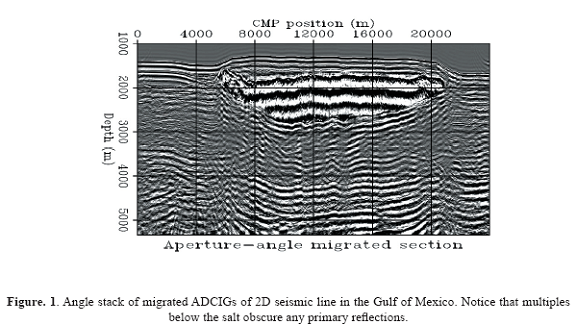
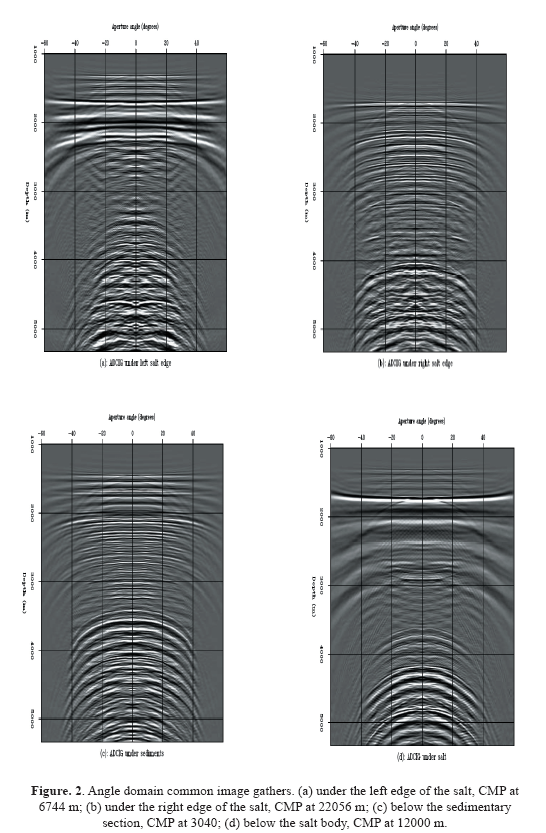
APEX-SHIFTED RADON TRANSFORM
In order to account for the apex-shift of the diffracted multiples (h), it is defined the forward and ad-joint Radon transforms as a modified version of the “tangent-squared” Radon transform introduced by Biondi and Symes (2003). The transformation is defined from data space (ADCIGs) to model space (Radon-transformed domain) as:

And from model space to data space as

Where z is depth in the data space  , is the aperture angle, z´ is the depth in the model space, q is the moveout curvature and h is the lateral apex shift. In this way, the two dimensional data space of ADCIGs,
, is the aperture angle, z´ is the depth in the model space, q is the moveout curvature and h is the lateral apex shift. In this way, the two dimensional data space of ADCIGs,  , is transformed into a three-dimensional model space, m(z´,q,h).
, is transformed into a three-dimensional model space, m(z´,q,h).
In an ideal case, primaries would be perfectly horizontal in the ADCIGs and would thus map in the model space to the zero-curvature (q = 0) plane (e.g., a plane of dimensions depth and apex-shift distance (h,z´)). Specularly-reflected multiples would map to the zero apex-shift distance (h = 0) plane, e.g., a plane of dimensions depth and curvature (q,z´). Diffracted multiples would map elsewhere in the cube depending on their curvature and apex-shift distance.
SPARSITY CONSTRAINT
As a linear transformation, the apex-shifted Radon transform can be represented simply as

Where d is the image in the angle domain, m is the image in the Radon domain and L is the forward apex-shifted Radon transform operator. To find the model m that best fits the data in a least-squares sense, the objective function is minimized as:

The second term in the equation is a Cauchy regularization that enforces sparseness in the model space. Here n is the size of the model space, and and b are two constants chosen a-priori: which controls the amount of sparseness in the model space and b related to the minimum value below which everything in the Radon domain should be zeroed (Sava and Guitton, 2003). The least-squares inverse of m is
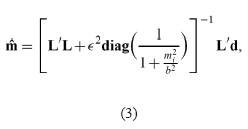
In equation (3) diag defines a diagonal operator. Because the model space can be large, m was estimated iteratively. Notice that the objective function in Equation (2) is non-linear because the model appears in the definition of the regularization term. Therefore, a limited-memory quasi-Newton method (Guitton and Symes, 2003) is used to find the minimum of f (m).
A LOOK AT THE 3D RADON DOMAIN
In this section the mapping of the different events between the image space and the 3D Radon space (z´,q,h) will be illustrated using the ADCIG at CMP 6744 m (Figure 2a). This ADCIG has no discernible primaries below the salt, but nicely shows the apex-shifted moveout of the diffracted multiples.Figure 3a shows the h = 0 plane from the 3D volume. This plane corresponds to the zero apex-shift and is therefore similar to the standard 2D Radon transform. Primaries are mapped near the q = 0 line, and specularly-reflected multiples are mapped to other q values. Diffracted multiples, since their moveout apex is not zero, are not mapped to this plane and do not obscure the mapping of the specularly-reflected multiples. For comparison, Figure 3b shows the 2D Radon transform, plotted at the same clip value as Figure 3a. Notice how the diffracted-multiple energy is mapped as background noise, especially at the largest positive and negative q values. Notice also that the primary energy is higher than in Figure 3a since with the 3D transform the primary energy is mapped not only to the h = 0 plane but to others h planes as well. This is further illustrated on Figure 4, which shows the zero-curvature (q = 0) plane for the same ADCIG. The nearly flat primaries have zero curvature for all values of the apex-shift distance h, so in this plane they appear as horizontal lines. Neither the specularly-reflected nor the diffracted multiples map to this plane.
and the 3D Radon space (z´,q,h) will be illustrated using the ADCIG at CMP 6744 m (Figure 2a). This ADCIG has no discernible primaries below the salt, but nicely shows the apex-shifted moveout of the diffracted multiples.Figure 3a shows the h = 0 plane from the 3D volume. This plane corresponds to the zero apex-shift and is therefore similar to the standard 2D Radon transform. Primaries are mapped near the q = 0 line, and specularly-reflected multiples are mapped to other q values. Diffracted multiples, since their moveout apex is not zero, are not mapped to this plane and do not obscure the mapping of the specularly-reflected multiples. For comparison, Figure 3b shows the 2D Radon transform, plotted at the same clip value as Figure 3a. Notice how the diffracted-multiple energy is mapped as background noise, especially at the largest positive and negative q values. Notice also that the primary energy is higher than in Figure 3a since with the 3D transform the primary energy is mapped not only to the h = 0 plane but to others h planes as well. This is further illustrated on Figure 4, which shows the zero-curvature (q = 0) plane for the same ADCIG. The nearly flat primaries have zero curvature for all values of the apex-shift distance h, so in this plane they appear as horizontal lines. Neither the specularly-reflected nor the diffracted multiples map to this plane.
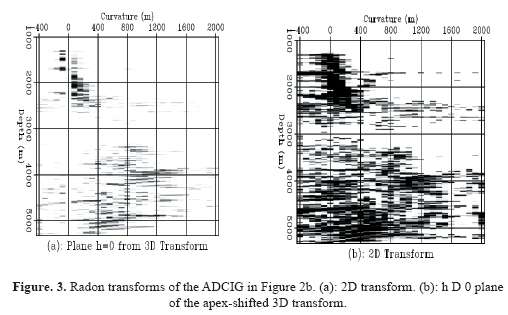
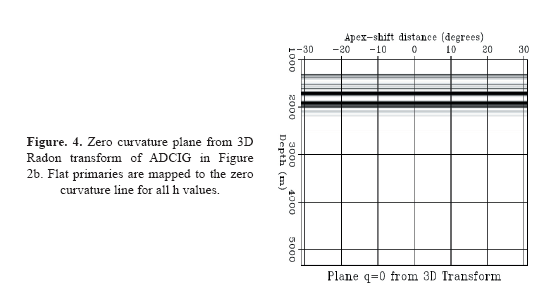
ATTENUATION OF DIFFRACTED AND SPECULARLY-REFLECTED MULTIPLES
With ideal data, attenuating both specularly-reflected and diffracted multiples could be, in principle, accomplished simply by zeroing out (with a suitable taper) all the q-planes except the one corresponding to q = 0 in the cube model m(z´,q,h), and taking the inverse apex-shifted Radon transform. In practice, however, the primaries may not be well-corrected and primary energy may map to a few other q-planes. Energy from the multiples may also map to those planes and so we have the usual trade-off of primary preservation versus multiple attenuation. The advantage is that the diffracted multiples are well focused to their corresponding h-planes and can be easily attenuated. Rather than suppressing the multiples in the domain model, we chose to suppress the primaries and inverse transform the multiples to the data space. The primaries were then recovered by subtracting the multiples from the data.
Figure 5 shows a close-up comparison of the primaries extracted with the standard 2D transform (Sava and Guitton, 2003) and with the apex-shifted Radon transform for the two ADCIGs at the top in Figure 5. The standard transform (Figures 5a and 5c) was effective in attenuating the specularly-reflected multiples, but failed at attenuating the diffracted multiples (below 4000 m), which are left as residual multiple energy in the primary data. Again, this is a consequence of the apex shift of these multiples. There appears not to be any sub-salt primary in Figures 5a and 5b, and only one clearly visible sub-salt primary in Figures 5c and 5d (just above 4400 m). This primary was well preserved with both transformations.
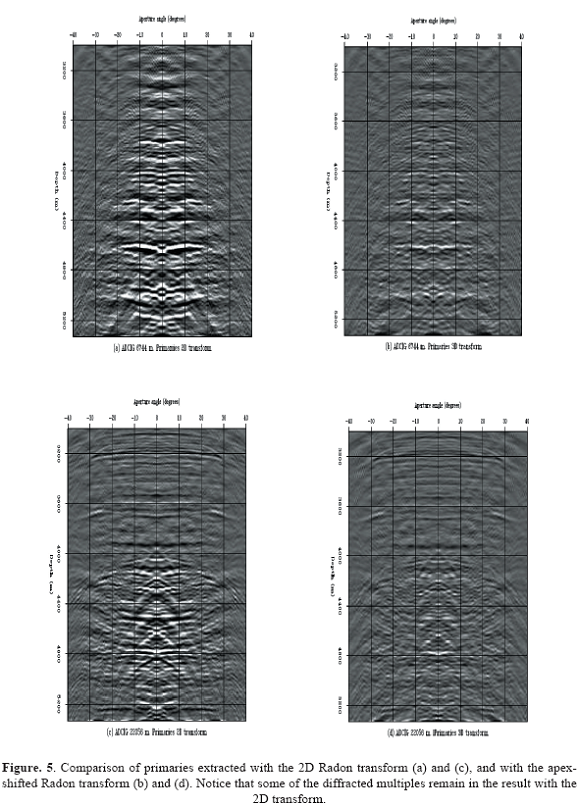
Figure 6 shows a similar comparison for the extracted multiples. Notice how the diffracted multiples were correctly identified and extracted by the 3D Radon transform (Figure 6b). In contrast, the standard 2D transform misrepresent the diffracted multiples as though they are specularly-reflected multiples as seen in Figure 6a. The 3D model representation could be successfully used to separate the diffracted multiples from the specularly-reflected ones (Figure 7). The diffracted multiples are clearly seen in Figure 6c.
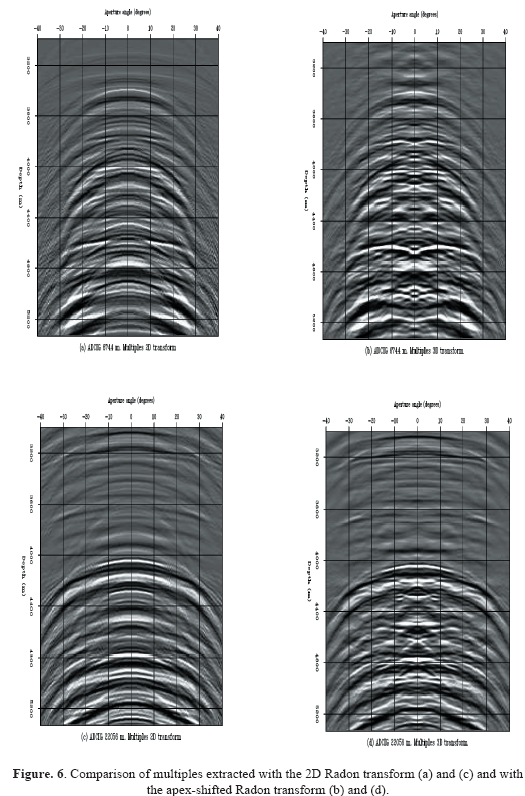
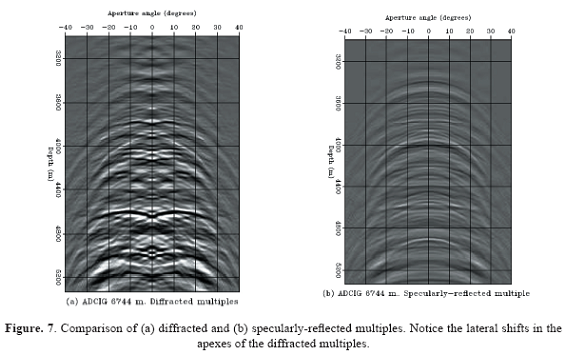
In order to assess the effect of better attenuation of the diffracted multiples on the angle stack of the ADCIGs, a total of 310 ADCIGs corresponding to horizontal positions 3000 m to 11000 m were processed (Figure 8). Figure 9 shows a close-up view of the stack of the primaries extracted with the 2D Radon transform, the stack of the primaries extracted with the 3D Radon transform and their difference. Notice that the diffracted multiple energy below the edge of the salt (5000 m to 7000 m) appearing as highly dipping events with the 2D transform has been attenuated with the 3D transform. This is shown in detail in Figure 9c. It is very difficult to identify any primary reflections below the edge of the salt, so it is hard to assess if the primaries have been equally preserved with both methods. It is known, however, that for this dataset, there are no multiples above a depth of about 3600 m, between 3000 m to 5000 m CMP positions. The fact that the difference panel appears nearly white in that zone shows that the attenuation of the diffracted multiples did not affect the primaries. Of course, this is only true for those primaries that were correctly imaged, so that their moveout in the ADCIGs was nearly flat. Weak sub-salt primaries may not have been well-imaged due to inaccuracies in the migration velocity field and may therefore have been attenuated with both the 2D and the 3D Radon transform.
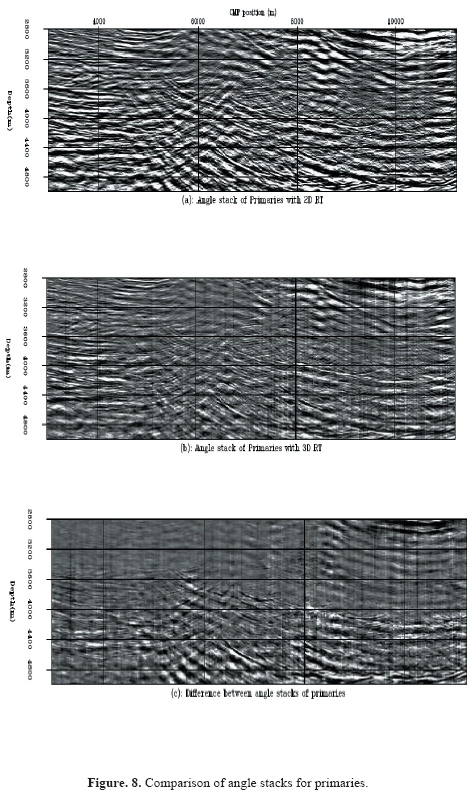
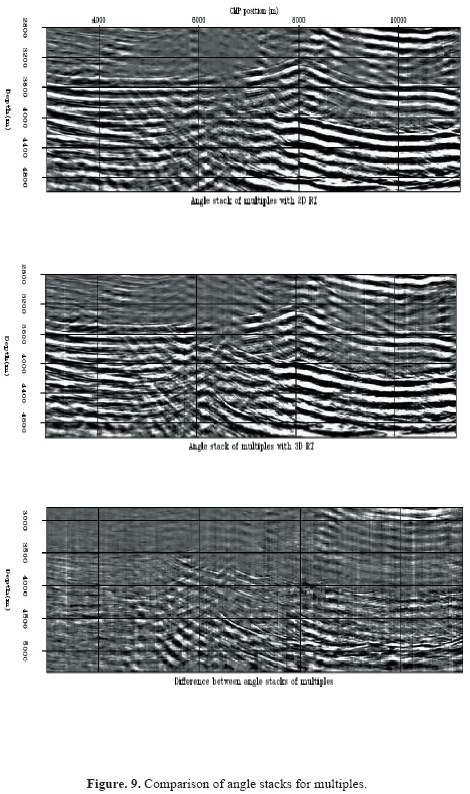
Figure 9 shows the extracted multiples with the 2D and the 3D Radon transform and their difference. Again, the main difference is largely in the diffracted multiples.
DISCUSSION
The results shown in the previous section demonstrate that with the 3D Radon transform it is possible to attenuate, although not completely remove, the diffracted multiples. It should be noted, however, that in this seismic section it is very difficult to find a legitimate primary reflection below the salt and in particular below the edge of the salt, where the contamination by the diffracted multiples is stronger. It is somewhat disappointing that the attenuation of the diffracted multiples did not help uncovering any meaningful primary reflections in this case. It is expect that this situation will be different with other datasets.
As stated earlier, working with space images (ADCIGs in this case) is convenient because the migration takes care of the complexity of the wave field propagation, but attenuating the multiples after migration does not come out without a price. The estimation of the migration velocities may be more difficult and less accurate because of the presence of the multiples. There is an inherent trade-off when choosing to work in space-image. Good migration velocities for weak sub-salt primaries may be particularly difficult to estimate in the presence of the multiples. On the other hand, the parabolic or hyperbolic assumption for the moveout of the multiples in data space may not be appropriate at all in complex media. An alternative could be doing a standard Radon demultiple before pre-stack migration to facilitate the choice of the migration velocities, and 3D Radon demultiple on the ADCIGs to attenuate residual multiples, in particular diffracted multiples.
It is also emphasized that adding the extra dimension to deal with the diffracted multiples does not resolve by itself the usual problem that non-flat primaries may map to the multiple region, and primary preservation is trade-off for multiple attenuation. This limitation forced to let some residual multiple energy leak into the extracted primaries. Obviously, the flatter the primaries in the ADCIGs, the better are the chances to reduce the residual multiple energy.
CONCLUSION
The combination of choosing the space image in the form of ADCIGs and the apex-shifted tangent-squared transformation from  to (z´,q,h) has proven to be effective in attenuating specularly-reflected and diffracted multiples in 2D marine data. The residual moveout of both multiples in ADCIGs is well-behaved and the extra dimension provided by the apex-shift allows the attenuation of the multiples without compromising the integrity of the primaries.
to (z´,q,h) has proven to be effective in attenuating specularly-reflected and diffracted multiples in 2D marine data. The residual moveout of both multiples in ADCIGs is well-behaved and the extra dimension provided by the apex-shift allows the attenuation of the multiples without compromising the integrity of the primaries.
ACKNOWLEDGMENTS
We thank the sponsors of the Stanford Exploration Project for their support to carry out this study and WesternGeco for providing the dataset.
REFERENCES
Biersteker, J. (2001). Magic: Shell's surface multiple attenuation technique. In: `71st Ann. Internat. Mtg Soc. of Expl'. Geophys. 1301-1304. [ Links ]
Biondi, B. and Symes, W. (2003). Angle-domain common-image gathers for migration velocity analysis by wavefield-continuation imaging. SEP-113. 177-210. [ Links ]
Guitton, A. and Symes, W. (2003). Robust inversion of seismic data using the Huber norm.Geophysics. 68 (4).1310-1319. [ Links ]
Hargreaves, N., Ver West, B., Wombell, R., and Trad, D. (2003). Multiple attenuation using an apex-shifted radon transform. 73rd Ann. Internat. Mtg., Soc. of Exp. Geophys., Expanded Abstracts. 1929-1932. [ Links ]
Nekut, A., (1998). 3d surface-related multiple elimination. 68th Ann. Internat. Mtg., Soc. ofExp. Geophys., Expanded Abstracts. 1511-1514. [ Links ]
Sava, P. and Fomel, S. (2003). Angle-domain common-image gathers by wavefield continuation methods. Geophysics. 68 (3). 1065-1074. [ Links ]
Sava, P. and Guitton, A., (2003). Multiple attenuation in the image space. SEP-113. 31-44. [ Links ]
Tisserant, T. and Biondi, B. (2003). Kinematics of 3-D angle-domain common-image gathers for migration velocity analysis. SEP-114. 71-82. [ Links ]
Trad, D. (2002). Interpolation with migration operators. 72nd Ann. Internat. Mtg., Soc. of Exp. Geophys., Expanded Abstracts, 2174-2177. [ Links ]
Van Dedem, E. and Verschuur, D., 1998, 3d surface-related multiple elimination and interpolation: 68th Ann. Internat. Mtg., Soc. of Exp. Geophys., Expanded Abstracts, 1321-1324. [ Links ]
Verschuur, D., Berkhout, A., and Wapenaar, C., (1992). Adaptive surface-related multiple elimination. Geophysics. 57 (9). 1166-1167. [ Links ]














